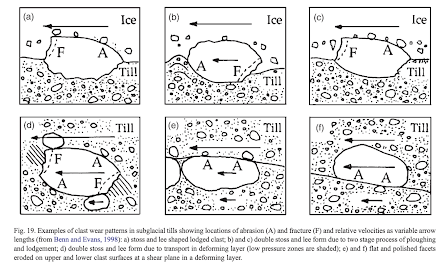Subglacial till: Formation, sedimentary characteristics and classification
September 2006
Earth-Science Reviews 78(1)
September 2006
Earth-Science Reviews 78(1)
December 2010
Antarctic Science 22(6)
DOI:
10.1017/S0954102010000799
B.C. Storey
David Fink
D. Hood
Mark Stevens et al
Antarctic Science 22(6)
DOI:
10.1017/S0954102010000799
B.C. Storey
David Fink
D. Hood
Mark Stevens et al
See also:
This paper discusses the "double stoss-lee form". I can understand how the stoss-lee form is created by streaming and abrasion on the up-glacier end of a bullet-shaped clast, and pressure-induced fracturing at the lee end. But I am not all that convinced by the "double" part of the theory.......... according to theory, fracturing and gouging is most likely to occur where the subject (boulder or bedrock mass)) is under tension and the object (tool) is under compression. Where the tool and the boulder are both under compression, abrasion is most likely to occur. I do not understand the theory that creates a low pressure zone on the up-glacier side of the boulder (situation d in the above diagram); and I am more inclined to think that if there is fracture damage on both ends of a bullet-shaped boulder it is most likely to have occurred because the boulder has been "flipped" or turned over.
Bullet-shaped clast with a stoss-lee form in front of Myrdalsjokull, Iceland. Ice moved from left to right. Note that there are several fractured faces at the lee end, suggesting some "rolling" of the clast during subglacial transport.
Some of the features of bullet-shaped clasts thought to have been fashioned in a subglacial environment. There are multiple variations on these themes, with intersecting fractures, rough scars which turn into polished facets, gouges in more or less random positions, and crossing striations. There will also be modifications related to the lithology and internal structure of the clast, related to foliations, ancient fractures, presence of quartz veins etc...... Many clasts made of sedimentary rock types will incline towards a more slab-like shape. (This diagram is based on field photos in my collection)
It should be emphasised that the majority of clasts in glacial deposits (moraine and till) are NOT shaped like this. To become "bullet shaped" a clast has to remain in a more or less constant alignment (the position of least resistance) for a long time. This allows the same set of processes to operate as we see with roches moutonnees. (See multiple posts on this blog -- use the search facility.) Most clasts are rolled and tumbled, with fractures occurring on all sides, which makes them eventually "block shaped" -- square or rectangular boulders (with their corners and edges knocked off) rather than elongated pillars.
Nonetheless, when you DO find a clast that has these "bullet" characteristics, it's a very good diagnostic feature pointing to subglacial transport.




No comments:
Post a Comment